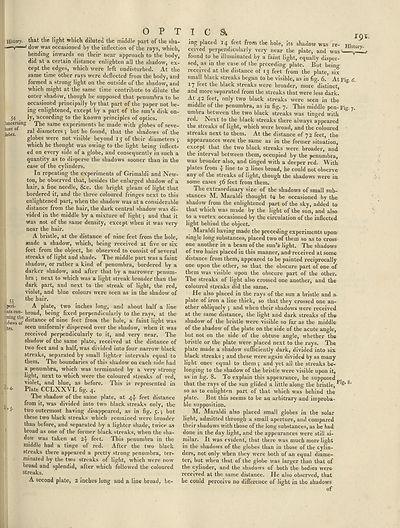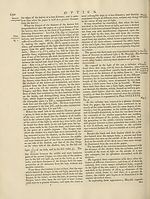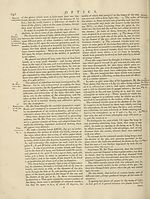Encyclopaedia Britannica > Volume 15, NIC-PAR
(211) Page 191
Download files
Complete book:
Individual page:
Thumbnail gallery: Grid view | List view

History.
54 .
loncerning
hose of
lobes.
i 55
i peri-
! nts con-
ming the
| -dews of
tes.
'•4-
f-S'
OPT
that the light which diluted the middle part of the sha¬
dow was occasioned by the inflection of the rays, which,
bending inwards on their near approach to the body,
did at a certain distance enlighten all the shadow, ex¬
cept the edges, which were left undisturbed. At the
same time other rays were deflected from the body, and
formed a strong light on the outside of the shadow, and
which might at the same time contribute to dilute the
outer shadow, though he supposed that penumbra to be
occasioned principally by that part of the paper not be¬
ing enlightened, except by a part of the sun’s disk on¬
ly, according to the known principles of optics.
The same experiments he made with globes of seve¬
ral diameters j but he found, that the shadows of the
globes were not visible beyond 15 of their diameters ;
which he thought was owing to the light being inflect¬
ed on every side of a globe, and consequently in such a
quantity as to disperse the shadows sooner than in the
case of the cylinders.
In repeating the experiments of Grimaldi and New¬
ton, he observed that, besides the enlarged shadow of a
hair, a fine needle, &c. the bright gleam of light that
bordered it, and the three coloured fringes next to this
enlightened part, when the shadow was at a considerable
distance from the hair, the dark central shadow was di¬
vided in the middle by a mixture of light ; and that it
was not of the same density, except when it was very
near the hair.
A bristle, at the distance of nine feet from the hole,
made a shadow, which, being received at five or six
feet from the object, he observed to consist of several
streaks of light and shade. The middle part was a faint
shadow, or rather a kind of penumbra, bordered by a
darker shadow, and after that by a narrower penum¬
bra ; next to which was a light streak broader than the
dark part, and next to the streak of light, the red,
violet, and blue colours were seen as in the shadow of
the hair.
A plate, two inches long, and about half a line
broad, being fixed perpendicularly to the rays, at the
distance of nine feet from the hole, a faint light was
seen uniformly dispersed over the shadow, when it was
received perpendicularly to it, and very near. The
shadow of the same plate, received at the distance of
two feet and a half, was divided into four narrow black
streaks, separated by small lighter intervals equal to
them. The boundaries of this shadow on each side had
a penumbra, which was terminated by a very strong
light, next to which were the coloured streaks of red,
violet, and blue, as before. This is represented in
Plate CCLXXVI. fig. 4.
The shadow of the same plate, at 4-? feet distance
from it, was divided into two black streaks only, the
two outermost having disappeared, as in fig. 5.; but
these two black streaks which remained were broader
than before, and separated by a lighter shade, twice as
broad as one of the former black streaks, when the sha¬
dow was taken at 2y feet. This penumbra in the
middle had a tinge of red. After the two black
streaks there appeared a pretty strong penumbra, ter¬
minated by the two streaks of light, which were now
broad and splendid, after which followed the coloured
streaks.
A second plate, 2 inches long and a line broad, be-
1 c &
ing placed 14 feet from the hole, its shadow was re¬
ceived perpendicularly very near the plate, and was
found to be illuminated by a faint light, equally disper¬
sed, as in the case of the preceding plate. But being
received at the distance of 13 feet from the plate, six
small black sti*eaks began to be visible, as in fig. 6. At Fig. 6.
17 feet the black streaks were broader, more distinct,
and more separated from the streaks that were less dark.
At 42 feet, only two black streaks were seen in the
middle of the penumbra, as in fig. 7. This middle pen-Fig. 7.
umbra between the two black streaks was tinged with
red. Next to the black streaks there always appeared
the streaks of light, which were broad, and the coloured
streaks next to them. At the distance of 72 feet, the
appearances were the same as in the former situation,
except that the two black streaks were broader, and
the interval between them, occupied by the penumbra,
was bioader also, and tinged with a deeper red. With
plates from 4 line to 2 lines broad, he could not observe
any of the streaks of light, though the shadows were in
some cases 56 feet from them.
The extraordinary size of the shadows of small sub¬
stances M, Maraldr thought to be occasioned by the
shadow from the enlightened part of the sky, added to
that which was made by the light of the sun, and also
to a vortex occasioned by the circulation of the inflected
light behind the object.
Maraldi having made the preceding experiments upon
single long substances, placed two of them so as to cross
one another in a beam of the sun’s light. The shadows
of two hairs placed in this manner, and received at some
distance from them, appeared to be painted reciprocally
one upon the other, so that the obscure part of one of
them was visible upon the obscure part of the other.
The streaks of light also crossed one another, and the
coloured streaks did the same.
He also placed in the rays of the sun a bristle and a.
plate of iron a line thick, so that they crossed one an¬
other obliquely 5 and when their shadows were received
at the same distance, the light and dark streaks of the
shadow of the bristle were visible so far as the middle
of the shadow of the plate on the side of the acute angle,
but not on the side of the obtuse angle, whether the
bristle or the plate were placed next to the rays. The
plate made a shadow sufficiently dark, divided into six
black streaks ; and these were again divided by as many
light ones equal to them ; and yet all the streaks be¬
longing to the shadow of the bristle were visible upon it,
as in fig. 8. To explain this appearance, he supposed
that the rays of the sun glided a little along the bristle, Flg:' 8‘
so as to enlighten part of that which was behind the
plate. But this seems to be an arbitrary and improba¬
ble supposition.
M. Maraldi also placed small globes in the solar
light, admitted through a small aperture, and compared
their shadows with those of the long substances, as he had
done in the day light, and the appearances were still si¬
milar. It was evident, that there was much more light
in the shadows of the globes than in those of the cylin¬
ders, not only when they were both of an equal diame¬
ter, but when that of the globe was larger than that of
the cylinder, and the shadows of both the bodies were
received at the same distance. He also observed, that
he could perceive no difference of light in the shadows
of
54 .
loncerning
hose of
lobes.
i 55
i peri-
! nts con-
ming the
| -dews of
tes.
'•4-
f-S'
OPT
that the light which diluted the middle part of the sha¬
dow was occasioned by the inflection of the rays, which,
bending inwards on their near approach to the body,
did at a certain distance enlighten all the shadow, ex¬
cept the edges, which were left undisturbed. At the
same time other rays were deflected from the body, and
formed a strong light on the outside of the shadow, and
which might at the same time contribute to dilute the
outer shadow, though he supposed that penumbra to be
occasioned principally by that part of the paper not be¬
ing enlightened, except by a part of the sun’s disk on¬
ly, according to the known principles of optics.
The same experiments he made with globes of seve¬
ral diameters j but he found, that the shadows of the
globes were not visible beyond 15 of their diameters ;
which he thought was owing to the light being inflect¬
ed on every side of a globe, and consequently in such a
quantity as to disperse the shadows sooner than in the
case of the cylinders.
In repeating the experiments of Grimaldi and New¬
ton, he observed that, besides the enlarged shadow of a
hair, a fine needle, &c. the bright gleam of light that
bordered it, and the three coloured fringes next to this
enlightened part, when the shadow was at a considerable
distance from the hair, the dark central shadow was di¬
vided in the middle by a mixture of light ; and that it
was not of the same density, except when it was very
near the hair.
A bristle, at the distance of nine feet from the hole,
made a shadow, which, being received at five or six
feet from the object, he observed to consist of several
streaks of light and shade. The middle part was a faint
shadow, or rather a kind of penumbra, bordered by a
darker shadow, and after that by a narrower penum¬
bra ; next to which was a light streak broader than the
dark part, and next to the streak of light, the red,
violet, and blue colours were seen as in the shadow of
the hair.
A plate, two inches long, and about half a line
broad, being fixed perpendicularly to the rays, at the
distance of nine feet from the hole, a faint light was
seen uniformly dispersed over the shadow, when it was
received perpendicularly to it, and very near. The
shadow of the same plate, received at the distance of
two feet and a half, was divided into four narrow black
streaks, separated by small lighter intervals equal to
them. The boundaries of this shadow on each side had
a penumbra, which was terminated by a very strong
light, next to which were the coloured streaks of red,
violet, and blue, as before. This is represented in
Plate CCLXXVI. fig. 4.
The shadow of the same plate, at 4-? feet distance
from it, was divided into two black streaks only, the
two outermost having disappeared, as in fig. 5.; but
these two black streaks which remained were broader
than before, and separated by a lighter shade, twice as
broad as one of the former black streaks, when the sha¬
dow was taken at 2y feet. This penumbra in the
middle had a tinge of red. After the two black
streaks there appeared a pretty strong penumbra, ter¬
minated by the two streaks of light, which were now
broad and splendid, after which followed the coloured
streaks.
A second plate, 2 inches long and a line broad, be-
1 c &
ing placed 14 feet from the hole, its shadow was re¬
ceived perpendicularly very near the plate, and was
found to be illuminated by a faint light, equally disper¬
sed, as in the case of the preceding plate. But being
received at the distance of 13 feet from the plate, six
small black sti*eaks began to be visible, as in fig. 6. At Fig. 6.
17 feet the black streaks were broader, more distinct,
and more separated from the streaks that were less dark.
At 42 feet, only two black streaks were seen in the
middle of the penumbra, as in fig. 7. This middle pen-Fig. 7.
umbra between the two black streaks was tinged with
red. Next to the black streaks there always appeared
the streaks of light, which were broad, and the coloured
streaks next to them. At the distance of 72 feet, the
appearances were the same as in the former situation,
except that the two black streaks were broader, and
the interval between them, occupied by the penumbra,
was bioader also, and tinged with a deeper red. With
plates from 4 line to 2 lines broad, he could not observe
any of the streaks of light, though the shadows were in
some cases 56 feet from them.
The extraordinary size of the shadows of small sub¬
stances M, Maraldr thought to be occasioned by the
shadow from the enlightened part of the sky, added to
that which was made by the light of the sun, and also
to a vortex occasioned by the circulation of the inflected
light behind the object.
Maraldi having made the preceding experiments upon
single long substances, placed two of them so as to cross
one another in a beam of the sun’s light. The shadows
of two hairs placed in this manner, and received at some
distance from them, appeared to be painted reciprocally
one upon the other, so that the obscure part of one of
them was visible upon the obscure part of the other.
The streaks of light also crossed one another, and the
coloured streaks did the same.
He also placed in the rays of the sun a bristle and a.
plate of iron a line thick, so that they crossed one an¬
other obliquely 5 and when their shadows were received
at the same distance, the light and dark streaks of the
shadow of the bristle were visible so far as the middle
of the shadow of the plate on the side of the acute angle,
but not on the side of the obtuse angle, whether the
bristle or the plate were placed next to the rays. The
plate made a shadow sufficiently dark, divided into six
black streaks ; and these were again divided by as many
light ones equal to them ; and yet all the streaks be¬
longing to the shadow of the bristle were visible upon it,
as in fig. 8. To explain this appearance, he supposed
that the rays of the sun glided a little along the bristle, Flg:' 8‘
so as to enlighten part of that which was behind the
plate. But this seems to be an arbitrary and improba¬
ble supposition.
M. Maraldi also placed small globes in the solar
light, admitted through a small aperture, and compared
their shadows with those of the long substances, as he had
done in the day light, and the appearances were still si¬
milar. It was evident, that there was much more light
in the shadows of the globes than in those of the cylin¬
ders, not only when they were both of an equal diame¬
ter, but when that of the globe was larger than that of
the cylinder, and the shadows of both the bodies were
received at the same distance. He also observed, that
he could perceive no difference of light in the shadows
of
Set display mode to:
![]() Universal Viewer |
Universal Viewer | ![]() Mirador |
Large image | Transcription
Mirador |
Large image | Transcription
Images and transcriptions on this page, including medium image downloads, may be used under the Creative Commons Attribution 4.0 International Licence unless otherwise stated. ![]()
| Encyclopaedia Britannica > Encyclopaedia Britannica > Volume 15, NIC-PAR > (211) Page 191 |
|---|
| Permanent URL | https://digital.nls.uk/192584441 |
|---|
| Attribution and copyright: |
|
|---|
| Shelfmark | EB.11 |
|---|---|
| Description | Ten editions of 'Encyclopaedia Britannica', issued from 1768-1903, in 231 volumes. Originally issued in 100 weekly parts (3 volumes) between 1768 and 1771 by publishers: Colin Macfarquhar and Andrew Bell (Edinburgh); editor: William Smellie: engraver: Andrew Bell. Expanded editions in the 19th century featured more volumes and contributions from leading experts in their fields. Managed and published in Edinburgh up to the 9th edition (25 volumes, from 1875-1889); the 10th edition (1902-1903) re-issued the 9th edition, with 11 supplementary volumes. |
|---|---|
| Additional NLS resources: |
|

